
Tourism Places In jaisalmerTourist Attractions of jaisalmer jaisalmer Fort Havelis of jaisalmer Jain Temples jaisalmer Gadi Sagar Lake Lodurva Temples Sam Sand Dunes Khuri Sand Dunes Desert Culture Centre and Museum The Fort 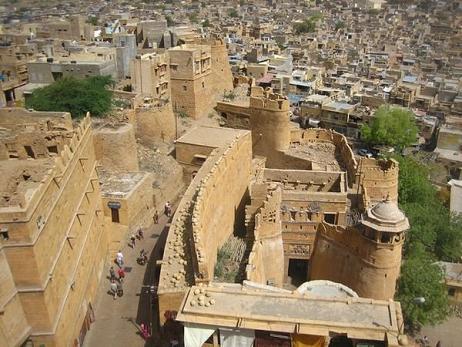 The golden hued fort is a sentinel to the bleak desertscape from its 80 metre high perch on the hill,housing the entire township within its ramparts.It has an enchanting cow-web of narrow lanes dotted with some lovely havelis,three beautifully sculptured Jain Temples of the 12th-15th century A.D. and five interconnected palaces.The fort is approached through four gateways-Akhaiyal,Ganesh Pol,Suraj Pol and Hava Pol. jaisalmer Fort is a monument worth visiting and worth retaining in your conscious mind. Like various other cities of Rajasthan, in jaisalmer too you will find different facets of its own glorious heritage. Though you can find historical monuments scattered all over the city, the jaisalmer Fort will immediately command your attention. Made of sand stones and locally known as Sonar Quila, the jaisalmer Fort is a dominating structure amidst sands.jaisalmer fort is the second oldest in Rajasthan. Two hundred and fifty feet tall and reinforced by imposing crenellated sandstone wall 30 feet high; it has 99 bastions, 92 of which were built between 1633 and 1647. Wells within the fort still provide a regular source of water. Even today, you will find that nearly one fourth of the old city's population resides within the fort. If you are a student of cross-cultural merging, the subtle fusion of Rajput and Islamic architectural styles, visible in this fort, will catch your fancy. Ganesh Pol, Akshya Pol, Suraj Pol and Hawa Pol are a must see.
The golden hued fort is a sentinel to the bleak desertscape from its 80 metre high perch on the hill,housing the entire township within its ramparts.It has an enchanting cow-web of narrow lanes dotted with some lovely havelis,three beautifully sculptured Jain Temples of the 12th-15th century A.D. and five interconnected palaces.The fort is approached through four gateways-Akhaiyal,Ganesh Pol,Suraj Pol and Hava Pol. jaisalmer Fort is a monument worth visiting and worth retaining in your conscious mind. Like various other cities of Rajasthan, in jaisalmer too you will find different facets of its own glorious heritage. Though you can find historical monuments scattered all over the city, the jaisalmer Fort will immediately command your attention. Made of sand stones and locally known as Sonar Quila, the jaisalmer Fort is a dominating structure amidst sands.jaisalmer fort is the second oldest in Rajasthan. Two hundred and fifty feet tall and reinforced by imposing crenellated sandstone wall 30 feet high; it has 99 bastions, 92 of which were built between 1633 and 1647. Wells within the fort still provide a regular source of water. Even today, you will find that nearly one fourth of the old city's population resides within the fort. If you are a student of cross-cultural merging, the subtle fusion of Rajput and Islamic architectural styles, visible in this fort, will catch your fancy. Ganesh Pol, Akshya Pol, Suraj Pol and Hawa Pol are a must see. Manak Chowk and Havelis 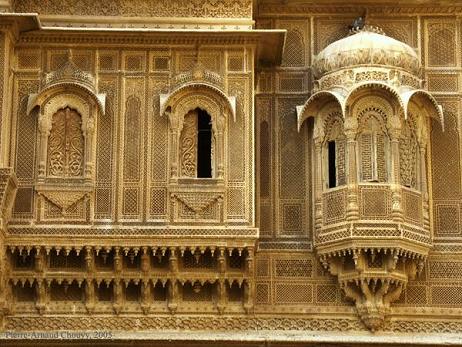 Outside the jaisalmer Fort, is the main market place called Manak Chowk which is the centre of local activity. From Manak Chowk, one can walk into the lanes where the famous carved havelies are to be found. Each haveli's facade differs from other. Built mainly during the 18 th and 19 th centuries, the carving in the havelies of jaisalmer is of a very superior quality.
A main marketplace outside the fort leads to the narrow lanes dotted with famous havelis.
The vibrant market place of Manak Chowk and Havelis is situated just outside the splendid architectural monument of the jaisalmer Fort. A prominent market place of jaisalmer in Rajasthan, the Manak Chowk and Havelis offers the tourists and the local indigenous inhabitants with a wonderful opportunity to explore the rich art and craft work of the place.
The Manak Chowk and Havelis is always full of life and vigor. The market is flooded with ethnic silver jewelries, highly decorative leather works, embroidered goods and antiques pieces of traditional craft works of the region. Any tourist who visits the jaisalmer Fort makes it a point to visit the local market of Manak Chowk.
Outside the jaisalmer Fort, is the main market place called Manak Chowk which is the centre of local activity. From Manak Chowk, one can walk into the lanes where the famous carved havelies are to be found. Each haveli's facade differs from other. Built mainly during the 18 th and 19 th centuries, the carving in the havelies of jaisalmer is of a very superior quality.
A main marketplace outside the fort leads to the narrow lanes dotted with famous havelis.
The vibrant market place of Manak Chowk and Havelis is situated just outside the splendid architectural monument of the jaisalmer Fort. A prominent market place of jaisalmer in Rajasthan, the Manak Chowk and Havelis offers the tourists and the local indigenous inhabitants with a wonderful opportunity to explore the rich art and craft work of the place.
The Manak Chowk and Havelis is always full of life and vigor. The market is flooded with ethnic silver jewelries, highly decorative leather works, embroidered goods and antiques pieces of traditional craft works of the region. Any tourist who visits the jaisalmer Fort makes it a point to visit the local market of Manak Chowk.Gadsisar Lake 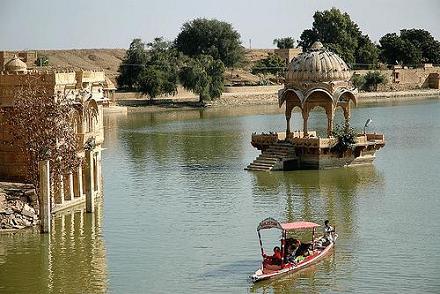 A scenic rain water lake with numerous beautiful shrines around and a spectacular avian variety. The lake is an idyllic spot for outings.About Gadisar lake . This tank outside the city walls, once held the town's water supply, and, befitting its importance in providing precious water to the inhabitants of this arid city, is surrounded by small temples and shrines. A wide variety of waterfowl flock here in winter. The tank was built by Maharaja Gadsi Singh, taking the advantage of a natural declivity that already retained some water.
A scenic rain water lake with numerous beautiful shrines around and a spectacular avian variety. The lake is an idyllic spot for outings.About Gadisar lake . This tank outside the city walls, once held the town's water supply, and, befitting its importance in providing precious water to the inhabitants of this arid city, is surrounded by small temples and shrines. A wide variety of waterfowl flock here in winter. The tank was built by Maharaja Gadsi Singh, taking the advantage of a natural declivity that already retained some water.Tazia Tower  The magnificent Tazia Tower rises from the splendid Badal Mahal, the Palace of Clouds and compliments the complete structure with its pagoda styled formations. Located near the Sagar gate, it stands as one of the best monument of Muslim architecture in Rajasthan. The five-tiered tower was a gift by the architects to their royal patrons. Ideally an imitation of the Mausoleum of various Imams, each storey of Tazia Tower has its own significance. Emanating an aura of royalty, Tazia Tower is a must see for all who love history steeped in mystic charm. The magnificent balconies of each tier remains till date a showpiece of intricate Muslim architecture.
A pagoda like structure looming up from the 'Badal Mahal' with beautiful 'Taazias'-ornately decorated bamboo,paper and tinsel replicas of a bier, carried out in procession during Moharram by the Muslims.
Tazia Tower of jaisalmer is one of the major tourist attractions. If you have done with the various Rajputana architectures scattered in the city, Tazia tower will come as a welcome break to you. It is situated in the excellent 'Badal Palace' complex located near Amar Sagar Gate. These were the homes of the former royal family. The Tazia tower is a 5-storied structure where each story has significance in its own. On each floor there is a balcony that is famous for their individual designs. This was built by Muslim craftsmen and is based on the shape of Tazia. Tazia is actually the replica of Mausoleum of various Imams. They are made of wood, thermocol and colored papers. The architects gifted it to the then royal patrons.
jaisalmer has immense tourists attraction. Though known more for its golden sand stone jaisalmer Fort, Tazia Tower of jaisalmer is not far behind in its popularity. A class apart from the Rajputana style of architecture, Tazia Tower is built in beautiful turret formation, intricately carved and aesthetically designed by Muslim crafts men.
The magnificent Tazia Tower rises from the splendid Badal Mahal, the Palace of Clouds and compliments the complete structure with its pagoda styled formations. Located near the Sagar gate, it stands as one of the best monument of Muslim architecture in Rajasthan. The five-tiered tower was a gift by the architects to their royal patrons. Ideally an imitation of the Mausoleum of various Imams, each storey of Tazia Tower has its own significance. Emanating an aura of royalty, Tazia Tower is a must see for all who love history steeped in mystic charm. The magnificent balconies of each tier remains till date a showpiece of intricate Muslim architecture.
A pagoda like structure looming up from the 'Badal Mahal' with beautiful 'Taazias'-ornately decorated bamboo,paper and tinsel replicas of a bier, carried out in procession during Moharram by the Muslims.
Tazia Tower of jaisalmer is one of the major tourist attractions. If you have done with the various Rajputana architectures scattered in the city, Tazia tower will come as a welcome break to you. It is situated in the excellent 'Badal Palace' complex located near Amar Sagar Gate. These were the homes of the former royal family. The Tazia tower is a 5-storied structure where each story has significance in its own. On each floor there is a balcony that is famous for their individual designs. This was built by Muslim craftsmen and is based on the shape of Tazia. Tazia is actually the replica of Mausoleum of various Imams. They are made of wood, thermocol and colored papers. The architects gifted it to the then royal patrons.
jaisalmer has immense tourists attraction. Though known more for its golden sand stone jaisalmer Fort, Tazia Tower of jaisalmer is not far behind in its popularity. A class apart from the Rajputana style of architecture, Tazia Tower is built in beautiful turret formation, intricately carved and aesthetically designed by Muslim crafts men.Havelis Some of the most exotic mansions or havelis,all intricately latticed are strew all over jaisalmer-each with a different facade. Nathmalji ki Haveli 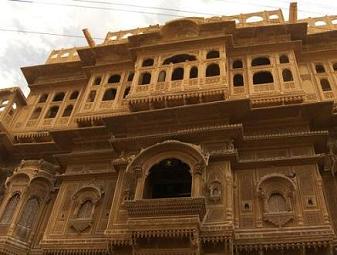 Nathmalji Ki Haveli in jaisalmer is foremost among the places of tourist interest in jaisalmer. A visit to jaisalmer and the haveli is sure to overwhelm you with the stone-carved screen windows, exquisitely executed murals, jewel like balconies and a rich architectural splendor. Two full-scale yellow sandstone elephants receive you at the access of Nathmalji Ki Haveli.
The late 19th century haveli with intricate architecture a display of sheer craftsmanship. The left and right wings of the mansion which were carved by two brothers are not identical but very similar and balanced in design. The interior walls are ornate with splendid miniature paintings.
This Nathmal Ji ki haveli was commissioned to serve as the residence of Diwan Mohata Nathmal, the then Prime Minister of jaisalmer. Maharawal Beri Sal commissioned the construction of this Haveli. The architects of this haveli were Hathi and Lulu who happened to be brothers. There is a very interesting story regarding its construction. It is said that the two brothers started building different facets of haveli simultaneously. In those days there were no such instruments, which could keep a track on continuity and thus when this building came up finally it had irregular shape.
Barring that, this haveli is still considered the best in jaisalmer in terms of grandeur. There are other minute details worth appreciation. For example there are two Elephants made of yellow stone. These life-size replicas have been put in front of the main entrance so that it looks as if they are guarding the Haveli. Other than these, there are pictures engraved on pillars and walls. These consist of Horses, Cattle, and depiction of Flora among other things. But the most interesting aspect of this haveli is the drawing of modern amenities such as cars, fans etc. It is said and believed that the Architect brothers dint see these things ever in their life and engraved it with mere help of their descriptions given by people who had seen it. Nathmalji Ki Haveli in jaisalmer is splendor among the havelis in jaisalmer. A major among the tourist attractions in jaisalmer, the Haveli was the house of Mohta Nathmal, the then prime minister (1885) at the jaisalmer royal court. Conceived by two Muslim engineers, Lulu and Hathi, it is an epitome of Rajput skills.
Nathmalji Ki Haveli in jaisalmer, Rajasthan exhibits perfect architectural luxury on your Visit to jaisalmer. The designers exhibited unwavering tenacity and dexterity in executing the massive haveli. Though built on one building plan and the architectural brilliance, the two wings were built differently. However, the two wings seem to have faultless harmony. The walls are ornamented with stone figurines of horses, flowers, birds, elephants and interesting patterns that resemble extravagant pieces of out of the ordinary jewelry.
Nathmalji Ki Haveli in jaisalmer is foremost among the places of tourist interest in jaisalmer. A visit to jaisalmer and the haveli is sure to overwhelm you with the stone-carved screen windows, exquisitely executed murals, jewel like balconies and a rich architectural splendor. Two full-scale yellow sandstone elephants receive you at the access of Nathmalji Ki Haveli.
The late 19th century haveli with intricate architecture a display of sheer craftsmanship. The left and right wings of the mansion which were carved by two brothers are not identical but very similar and balanced in design. The interior walls are ornate with splendid miniature paintings.
This Nathmal Ji ki haveli was commissioned to serve as the residence of Diwan Mohata Nathmal, the then Prime Minister of jaisalmer. Maharawal Beri Sal commissioned the construction of this Haveli. The architects of this haveli were Hathi and Lulu who happened to be brothers. There is a very interesting story regarding its construction. It is said that the two brothers started building different facets of haveli simultaneously. In those days there were no such instruments, which could keep a track on continuity and thus when this building came up finally it had irregular shape.
Barring that, this haveli is still considered the best in jaisalmer in terms of grandeur. There are other minute details worth appreciation. For example there are two Elephants made of yellow stone. These life-size replicas have been put in front of the main entrance so that it looks as if they are guarding the Haveli. Other than these, there are pictures engraved on pillars and walls. These consist of Horses, Cattle, and depiction of Flora among other things. But the most interesting aspect of this haveli is the drawing of modern amenities such as cars, fans etc. It is said and believed that the Architect brothers dint see these things ever in their life and engraved it with mere help of their descriptions given by people who had seen it. Nathmalji Ki Haveli in jaisalmer is splendor among the havelis in jaisalmer. A major among the tourist attractions in jaisalmer, the Haveli was the house of Mohta Nathmal, the then prime minister (1885) at the jaisalmer royal court. Conceived by two Muslim engineers, Lulu and Hathi, it is an epitome of Rajput skills.
Nathmalji Ki Haveli in jaisalmer, Rajasthan exhibits perfect architectural luxury on your Visit to jaisalmer. The designers exhibited unwavering tenacity and dexterity in executing the massive haveli. Though built on one building plan and the architectural brilliance, the two wings were built differently. However, the two wings seem to have faultless harmony. The walls are ornamented with stone figurines of horses, flowers, birds, elephants and interesting patterns that resemble extravagant pieces of out of the ordinary jewelry.
Patwon ki Haveli 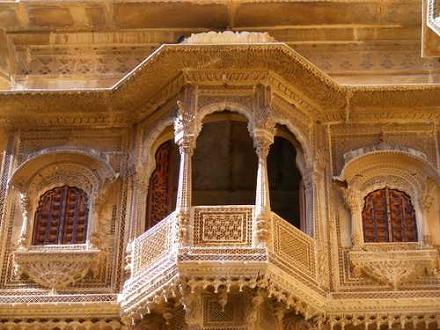 The most elaborate and magnificent of all the jaisalmer havelis. It has exquisitely carved pillars and extensive corridors and chambers.One of the apartments of this five storey high haveli is painted with beautiful murals.
The five-storied Patwon ki Haveli is the largest of its kind in jaisalmer, Rajasthan, India. Patwon ki haveli is one of the most elaborate and fascinating mansions in jaisalmer that entices you with its hypnotic charm.
Located on a narrow lane in the main jaisalmer city, Patwon ki haveli was constructed by Guman Chand Patwa and his five sons. Guman Chand was a famous trader of his times and dealt in gold, brocade and silver.
There are five massive suites in the Patwon ki haveli that are decorated with brilliant representations of artistic acumen. The entire haveli is and interesting grid of pillared halls, large corridors, lavishly chiseled ceilings and ostentatiously decorated walls. The stunning murals that adorn the haveli walls are colorful depictions of the everyday court scenes, village scenes and other artistic concepts.
The walls of one particular room at the Patwon ki Haveli is completely covered with captivating frescoes.
A part of Patwon ki haveli is owned by the Archaeological Survey of India, a part of it is owned by a family and the rest of it is owned by families who run craft shops within the premises.
The most elaborate and magnificent of all the jaisalmer havelis. It has exquisitely carved pillars and extensive corridors and chambers.One of the apartments of this five storey high haveli is painted with beautiful murals.
The five-storied Patwon ki Haveli is the largest of its kind in jaisalmer, Rajasthan, India. Patwon ki haveli is one of the most elaborate and fascinating mansions in jaisalmer that entices you with its hypnotic charm.
Located on a narrow lane in the main jaisalmer city, Patwon ki haveli was constructed by Guman Chand Patwa and his five sons. Guman Chand was a famous trader of his times and dealt in gold, brocade and silver.
There are five massive suites in the Patwon ki haveli that are decorated with brilliant representations of artistic acumen. The entire haveli is and interesting grid of pillared halls, large corridors, lavishly chiseled ceilings and ostentatiously decorated walls. The stunning murals that adorn the haveli walls are colorful depictions of the everyday court scenes, village scenes and other artistic concepts.
The walls of one particular room at the Patwon ki Haveli is completely covered with captivating frescoes.
A part of Patwon ki haveli is owned by the Archaeological Survey of India, a part of it is owned by a family and the rest of it is owned by families who run craft shops within the premises.
Salim Singh ki Haveli 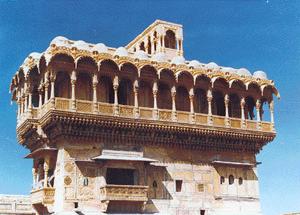 This 300 year old haveli of jaisalmer's Prime Minister Maharaja Rawal Gaj Singh-Salim Singh, has a beautiful blue cupola roof with superbly carved brackets in the form of peacocks.This extraordinary mansion in yellow stone is covered with intricate carvings and has an elaborate projecting balcony on the top storey.The mansion is one of the most notable of the array of havelis.
Rajasthan jaisalmer tours must definitely entail tours to Salim Singh Ki haveli that stands in mute testimony to the splendorous jaisalmer past towards the eastern end of jaisalmer city. This stately jaisalmer haveli with its stunning blue cupola roof is resplendent with exquisite stone carvings, screen windows and exotic murals.
The intricately chiseled brackets on the walls of Salim Singh ki haveli speak volumes about the love for detail and beauty among the artisans of those days. The sheer lavishness of extensive corridors, massive rooms and hallways weaves a bewitching spell on you.
Vibrant, graceful and stylish murals on the walls of Salim Singh ki haveli add an extra opulent charm to this lovely medieval mansion that was named after Salim Singhji, who was the prime minister in the jaisalmer royal court.
Salim Singh ki Haveli served as residence to the members of the Mohta family for decades. Most of the ministers in the jaisalmer royal court were descendants of the Mohta family. The haveli draws its name from Salim Singh, who was an important minister in the jaisalmer royal court and a shrewd statesman who was later murdered for conspiring against the royal throne.
It is believed that there were two more storeys over the existing five storied structure, that were torn down by the orders of the royal court of jaisalmer as a prime ministers home could not be of the same height as that of the royal palace.
Salim Singh ki haveli has been built on the remains of an older haveli built in the late 17th century. The new building was built in the year 1815 and was occupied by the Mehta family of jaisalmer. They were the most influential family of their time. This haveli was commissioned by Salim Singh, the then Prime Minister of the kingdom when jaisalmer was the capital.
The haveli has a distinct architecture. The roof has been constructed in the form of Peacock. The haveli is situated beside the hills near the jaisalmer Fort. People claim that Salim Singh made two additional floors in order to make it as high as the fort but the Maharaja did not take this attempt in good spirit. He ordered the extra floors to be torn down. Nevertheless we do not find enough evidence to corroborate the story.
Like other havelis in jaisalmer, this too has tuskers guarding the gateways. These are made of sand stones and look very close to the original in appearance. The haveli consists of as many as 38 balconies and they all have distinct designs for themselves. The front facet of the haveli resembles ship stern and thus this haveli is also sometimes referred as Jahazmahal.
This 300 year old haveli of jaisalmer's Prime Minister Maharaja Rawal Gaj Singh-Salim Singh, has a beautiful blue cupola roof with superbly carved brackets in the form of peacocks.This extraordinary mansion in yellow stone is covered with intricate carvings and has an elaborate projecting balcony on the top storey.The mansion is one of the most notable of the array of havelis.
Rajasthan jaisalmer tours must definitely entail tours to Salim Singh Ki haveli that stands in mute testimony to the splendorous jaisalmer past towards the eastern end of jaisalmer city. This stately jaisalmer haveli with its stunning blue cupola roof is resplendent with exquisite stone carvings, screen windows and exotic murals.
The intricately chiseled brackets on the walls of Salim Singh ki haveli speak volumes about the love for detail and beauty among the artisans of those days. The sheer lavishness of extensive corridors, massive rooms and hallways weaves a bewitching spell on you.
Vibrant, graceful and stylish murals on the walls of Salim Singh ki haveli add an extra opulent charm to this lovely medieval mansion that was named after Salim Singhji, who was the prime minister in the jaisalmer royal court.
Salim Singh ki Haveli served as residence to the members of the Mohta family for decades. Most of the ministers in the jaisalmer royal court were descendants of the Mohta family. The haveli draws its name from Salim Singh, who was an important minister in the jaisalmer royal court and a shrewd statesman who was later murdered for conspiring against the royal throne.
It is believed that there were two more storeys over the existing five storied structure, that were torn down by the orders of the royal court of jaisalmer as a prime ministers home could not be of the same height as that of the royal palace.
Salim Singh ki haveli has been built on the remains of an older haveli built in the late 17th century. The new building was built in the year 1815 and was occupied by the Mehta family of jaisalmer. They were the most influential family of their time. This haveli was commissioned by Salim Singh, the then Prime Minister of the kingdom when jaisalmer was the capital.
The haveli has a distinct architecture. The roof has been constructed in the form of Peacock. The haveli is situated beside the hills near the jaisalmer Fort. People claim that Salim Singh made two additional floors in order to make it as high as the fort but the Maharaja did not take this attempt in good spirit. He ordered the extra floors to be torn down. Nevertheless we do not find enough evidence to corroborate the story.
Like other havelis in jaisalmer, this too has tuskers guarding the gateways. These are made of sand stones and look very close to the original in appearance. The haveli consists of as many as 38 balconies and they all have distinct designs for themselves. The front facet of the haveli resembles ship stern and thus this haveli is also sometimes referred as Jahazmahal.
Jain Temple 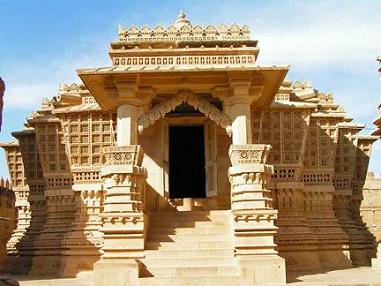 The fort has three exquisitely carved jain temples dedicated to the Jain Tirthankars-Rishabhdev,Sambhavnath and Paraswanath.
Jain Temples situated in the jaisalmer Fort are a must visit site in jaisalmer, Rajasthan. You will find these temples to be very old and high pilgrimage as well as archeological value attached to them. These are a group of Jain temples dating back 12th and 15th centuries and are dedicated to various Jain Tirthankars (Hermits). On the walls of the temples, you can find animal & human figures, carved in famous Dilwara style.
These temples are built in the Dilwara style that is famous all over the world for its architecture. The style got its name from the famous 'Dilwara Temples' situated on Mount Abu, a famous Hill station and pilgrimage destination in Rajasthan. The Jain temples in the jaisalmer Fort are dedicated to Rikhabdevji and Shambhavdev Ji, the famous Jain hermits known as 'Tirthankars'. Like all other structures in jaisalmer, these temples are craved of yellow sandstones. The beautifully carves decorations on the wall will give you divine peace. The Astapadhi Temples that are situated in the same complex are a must visit too.
The temple complex is open through out the morning till 12noon, for the visitors. So try to get up a bit early or you might miss this splendor. The campus also contain Gyan Bhandar library. Well if you are a student of comparative archeology or otherwise, the library will prove to be a good place to prowl as it contains some of the rare manuscripts available in India.
About The Jain Temple
Within the fort walls, there are seven beautifully carved Jain Temples built between the 12th and 15th centuries. The cluster of temples is connected by a series of corridors and walkways. Shoes and all leather items must be removed before entering the temple.
The first temple you come around is the one dedicated to Chandraprabhu, the eighth tirthankar (Jain Teacher), whose symbol is the moon. It was built in 1509 and features fine sandstone sculpture in sandstone in Mandapa (Fore chamber of the inner sanctum of the temple).
To the right of the Chandraprabhu Temple is Rikhabdev temple. There are some fine sculptures around the walls protected by glass cabinets, and the pillars are beautifully sculpted with apsaras (Celestial Maiden) and gods. This temple has a lovely and tranquil atmosphere.
Other temples which may be currently closed to the non - Jains, include the temple dedicated to Parasnath, a few steps behind Chandraprabhu. Entry is via an enormous and beautifully carved torana (Gateway) that culminates the image of the Jain tirthankara its apex. There is a voluptuous carving of an apsara balancing a set of balls on her raised forearm.
A door to the south side of the temple leads to the small Shitalnath Temple, dedicated to the 10th tinrthankar. The image of Shitalnath enshrined here is composed of eight precious metals. A door in the north wall leads to the beautiful Sambhavnath Temple.
Steps lead from the courtyard before the Sambhavnath temple to the Shantinath Temple, which was built in1536. The enclosed gallery around the temple is flanked by hundreds of images of saints, some of marble and some of jaisalmer sandstone. Steps lead below the temple to Kunthunath Temple, which was also built in 1536.
Visit the Jain Temples of jaisalmer with Rajasthan Holiday and discover a world of divine peace and tranquil comfort.
The Jain temples jaisalmer are situated within the jaisalmer Fort walls and are among the most interesting tourist attractions of jaisalmer, Rajasthan, India.
There are seven Jain temples of which three are most important and are dedicated to Rikhabdevji, Paraswanathji and Sambhavnathji, the jaisalmer Jain temples belong to the Swetambar Sect and house some of the most beautiful stone sculptures.
Each temple is dedicated to a particular Jain tirthankara. The Paraswanathji Temple is the largest and the most beautiful.
There is an emerald statue of Lord Mahavira within the Paraswanath Temple sanctum that exudes an aura of peace and tolerance.
The splendid and enormous torana or gateway that leads to the Paraswanath Temple is mesmerizing and spectacular. Admire the intricately carved lotuses on the temple domes, expressive stone sculptures and inscriptions on the temple walls.
The fort has three exquisitely carved jain temples dedicated to the Jain Tirthankars-Rishabhdev,Sambhavnath and Paraswanath.
Jain Temples situated in the jaisalmer Fort are a must visit site in jaisalmer, Rajasthan. You will find these temples to be very old and high pilgrimage as well as archeological value attached to them. These are a group of Jain temples dating back 12th and 15th centuries and are dedicated to various Jain Tirthankars (Hermits). On the walls of the temples, you can find animal & human figures, carved in famous Dilwara style.
These temples are built in the Dilwara style that is famous all over the world for its architecture. The style got its name from the famous 'Dilwara Temples' situated on Mount Abu, a famous Hill station and pilgrimage destination in Rajasthan. The Jain temples in the jaisalmer Fort are dedicated to Rikhabdevji and Shambhavdev Ji, the famous Jain hermits known as 'Tirthankars'. Like all other structures in jaisalmer, these temples are craved of yellow sandstones. The beautifully carves decorations on the wall will give you divine peace. The Astapadhi Temples that are situated in the same complex are a must visit too.
The temple complex is open through out the morning till 12noon, for the visitors. So try to get up a bit early or you might miss this splendor. The campus also contain Gyan Bhandar library. Well if you are a student of comparative archeology or otherwise, the library will prove to be a good place to prowl as it contains some of the rare manuscripts available in India.
About The Jain Temple
Within the fort walls, there are seven beautifully carved Jain Temples built between the 12th and 15th centuries. The cluster of temples is connected by a series of corridors and walkways. Shoes and all leather items must be removed before entering the temple.
The first temple you come around is the one dedicated to Chandraprabhu, the eighth tirthankar (Jain Teacher), whose symbol is the moon. It was built in 1509 and features fine sandstone sculpture in sandstone in Mandapa (Fore chamber of the inner sanctum of the temple).
To the right of the Chandraprabhu Temple is Rikhabdev temple. There are some fine sculptures around the walls protected by glass cabinets, and the pillars are beautifully sculpted with apsaras (Celestial Maiden) and gods. This temple has a lovely and tranquil atmosphere.
Other temples which may be currently closed to the non - Jains, include the temple dedicated to Parasnath, a few steps behind Chandraprabhu. Entry is via an enormous and beautifully carved torana (Gateway) that culminates the image of the Jain tirthankara its apex. There is a voluptuous carving of an apsara balancing a set of balls on her raised forearm.
A door to the south side of the temple leads to the small Shitalnath Temple, dedicated to the 10th tinrthankar. The image of Shitalnath enshrined here is composed of eight precious metals. A door in the north wall leads to the beautiful Sambhavnath Temple.
Steps lead from the courtyard before the Sambhavnath temple to the Shantinath Temple, which was built in1536. The enclosed gallery around the temple is flanked by hundreds of images of saints, some of marble and some of jaisalmer sandstone. Steps lead below the temple to Kunthunath Temple, which was also built in 1536.
Visit the Jain Temples of jaisalmer with Rajasthan Holiday and discover a world of divine peace and tranquil comfort.
The Jain temples jaisalmer are situated within the jaisalmer Fort walls and are among the most interesting tourist attractions of jaisalmer, Rajasthan, India.
There are seven Jain temples of which three are most important and are dedicated to Rikhabdevji, Paraswanathji and Sambhavnathji, the jaisalmer Jain temples belong to the Swetambar Sect and house some of the most beautiful stone sculptures.
Each temple is dedicated to a particular Jain tirthankara. The Paraswanathji Temple is the largest and the most beautiful.
There is an emerald statue of Lord Mahavira within the Paraswanath Temple sanctum that exudes an aura of peace and tolerance.
The splendid and enormous torana or gateway that leads to the Paraswanath Temple is mesmerizing and spectacular. Admire the intricately carved lotuses on the temple domes, expressive stone sculptures and inscriptions on the temple walls.
Gyan Bhandar Some of the oldest manuscripts of India are found in this library established as a part of Jain temples. Gyan Bhandar, a library founded in 1500 A.D. by Acharya Maharaj Jin Bhadra Suri. This small underground vault houses priceless ancient illustrated manuscripts, some dating from the 11th century. Other exhibits include astrological charts and the Jain version of the Shroud of Turin: the Shroud of Gindhasuri, a Jain hermit and holy man who died in Ajmer. In a small locked cabinet are the images of Parasnath made of ivory and various precious stones including emerald and crystal. There are plans to shift the library outside the present location within the Jain temple so it can be visited Gyan Bhandar, literally means Treasury of knowledge, is a most wanted place by researchers and historians. Gyan Bhandar is a most valuable library established by Acharya Maharaj Jin Bhadra Suri in 1500 A.D. This small library is really a treasure of ancient manuscripts, many illustrations and astrological charts. The library is placed undergrounds and some of the displays are priceless dating back to 11th century. Many valuable inscriptions of Jains are also enclosed in this library and it includes the Shroud of Gindhasuri. A small cabinet containing the Parasnath images which are made of precious stones and ivory is an attraction in this library. Places near about jaisalmer Lodurva . 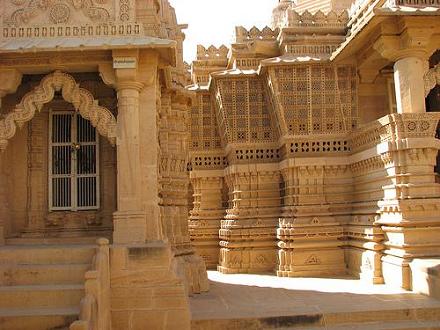 It's away from city 16 km . The ancient capital of jaisalmer and an important pilgrim spot of the Jain community with some magnificent Jain temple. "Toran' or the ornate arches at the main entrance and splendid carvings are noteworthy. A 'Kalptaru' or a divine tree within is the main attraction of the temple
Lodurva is the ancient capital of Bhattis Rajputs and was once a flourishing city but lost most of the splendor when the Bhattis shifted their capital to jaisalmer. Nevertheless this place is a major tourist attraction and attracts a lot of attention due to ruins of Jain temples. The most mesmerizing experience will be the peacock dance amid exotic Lodurva ruins. Yes, Peacocks are a great pull and they are in plenty here.
Lodurva is also known for its Jain temples. The temples are made of bright yellow sandstones. Though in ruins, the splendors of these Jain temples are clearly visible. You will find temple walls decorated with the pictures of Lord Parsvanath, the 23rd Jain Tirthankar. The beautiful Jaali works make these temples a piece of marvel. You will notice the splendid and dominating arch in the main temple building. These arches are typical of the Dilwara style of temple architecture.
About Lodurva
Further beyond Amar Sagar, 15 km northwest of jaisalmer, are the deserted ruins of Lodhurva, which was the ancient capital before the move to jaisalmer. It was probably founded by the Lodhra Rajputs, and passed to the ruler of Devagarh, Bhatti Devaraja, in 10th century. In 1025, Mahmud of Ghazni laid siege to the town, and it was sacked various times over subsequent decades, prompting Jaisala to shift the capital to a new location, resulting in the foundation of jaisalmer in 1156.
The Jain Temples, rebuilt in the late 1970s, are the only reminders of the city's former magnificence. The main temple enshrines an image of Parasnath, the 23rd tirthankar, and is finely wrought in silver and surrounded by fine sculptures.
It's away from city 16 km . The ancient capital of jaisalmer and an important pilgrim spot of the Jain community with some magnificent Jain temple. "Toran' or the ornate arches at the main entrance and splendid carvings are noteworthy. A 'Kalptaru' or a divine tree within is the main attraction of the temple
Lodurva is the ancient capital of Bhattis Rajputs and was once a flourishing city but lost most of the splendor when the Bhattis shifted their capital to jaisalmer. Nevertheless this place is a major tourist attraction and attracts a lot of attention due to ruins of Jain temples. The most mesmerizing experience will be the peacock dance amid exotic Lodurva ruins. Yes, Peacocks are a great pull and they are in plenty here.
Lodurva is also known for its Jain temples. The temples are made of bright yellow sandstones. Though in ruins, the splendors of these Jain temples are clearly visible. You will find temple walls decorated with the pictures of Lord Parsvanath, the 23rd Jain Tirthankar. The beautiful Jaali works make these temples a piece of marvel. You will notice the splendid and dominating arch in the main temple building. These arches are typical of the Dilwara style of temple architecture.
About Lodurva
Further beyond Amar Sagar, 15 km northwest of jaisalmer, are the deserted ruins of Lodhurva, which was the ancient capital before the move to jaisalmer. It was probably founded by the Lodhra Rajputs, and passed to the ruler of Devagarh, Bhatti Devaraja, in 10th century. In 1025, Mahmud of Ghazni laid siege to the town, and it was sacked various times over subsequent decades, prompting Jaisala to shift the capital to a new location, resulting in the foundation of jaisalmer in 1156.
The Jain Temples, rebuilt in the late 1970s, are the only reminders of the city's former magnificence. The main temple enshrines an image of Parasnath, the 23rd tirthankar, and is finely wrought in silver and surrounded by fine sculptures.
Wood Fossil Park, Aakal 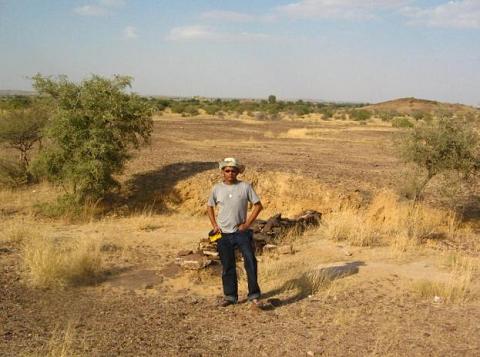 It's away from city 17 km .Lying on the Barmer Road , this park takes you back to the Jurassic period (when the whole Thar region lay under the sea) with 180 million year old fossils - the geological landmarks for the study of the Thar Desert.
Fossil Park archaeologists say occured 180 million years ago.
The fossils are said to represent non-flowering plants & provide a clue to the age of deposition ofsediments.
If you are done with history then Akal Fossil Park is the place to be. For, it takes you beyond History. It takes you back to the prehistoric Jurassic era, which is, hold your breath, 180 million years back! It is a fossil park where stood a forest 180 millions years ago. Then the area submersed in to the sea and the tree trunks got preserved in the form of fossils.
The fossil trunks lie scattered in this park. Fossilized tree trunks are of various sizes with the largest being 13 meters in length and 1.5 meters in width. Covering about 10 sq. Km of bare hillside, the Fossil Park contains 25 petrified trunks, in total. The 21-hectare preserved area of the park lies about 17 Km from jaisalmer on the road to Barmer.
If you happen to be a Conservationist or a Geologist by chance, try to get there early. Get there before tourists come pouring in. You will have to seek prior permission in order to study the remains.
Spread over 21 hectares, the Akal Wood Fossil Park is a unique experience. The reserve or park has been dated approximately to be 180 million years ago. The whole area is covered with huge fossilized tree trunks, one of which is 7 m by 1.5 m and ancient sea shells throwing light on the ancient geology of the state. Under the archeological department, further excavations are underway to bring to light more fossils.
It's away from city 17 km .Lying on the Barmer Road , this park takes you back to the Jurassic period (when the whole Thar region lay under the sea) with 180 million year old fossils - the geological landmarks for the study of the Thar Desert.
Fossil Park archaeologists say occured 180 million years ago.
The fossils are said to represent non-flowering plants & provide a clue to the age of deposition ofsediments.
If you are done with history then Akal Fossil Park is the place to be. For, it takes you beyond History. It takes you back to the prehistoric Jurassic era, which is, hold your breath, 180 million years back! It is a fossil park where stood a forest 180 millions years ago. Then the area submersed in to the sea and the tree trunks got preserved in the form of fossils.
The fossil trunks lie scattered in this park. Fossilized tree trunks are of various sizes with the largest being 13 meters in length and 1.5 meters in width. Covering about 10 sq. Km of bare hillside, the Fossil Park contains 25 petrified trunks, in total. The 21-hectare preserved area of the park lies about 17 Km from jaisalmer on the road to Barmer.
If you happen to be a Conservationist or a Geologist by chance, try to get there early. Get there before tourists come pouring in. You will have to seek prior permission in order to study the remains.
Spread over 21 hectares, the Akal Wood Fossil Park is a unique experience. The reserve or park has been dated approximately to be 180 million years ago. The whole area is covered with huge fossilized tree trunks, one of which is 7 m by 1.5 m and ancient sea shells throwing light on the ancient geology of the state. Under the archeological department, further excavations are underway to bring to light more fossils.
Sam Sand Dunes 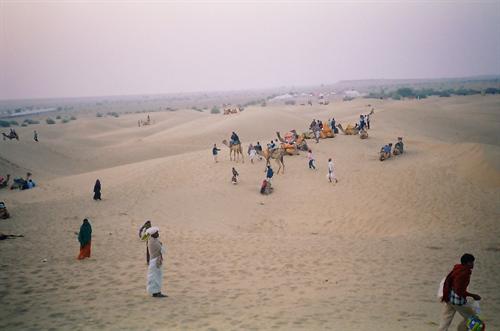 It's away from city 42 km . No trip to jaisalmer is complete without a trip to the most picturesque dunes of Sam. The ripples on the wind caressed dunes, that create an enchanting mirage, are surely a delight for a trigger happy photographer.
Various cultural programmes are organized against the backdrop of these fascinating sand dunes. Exciting camel safaris allow you to get the real feel of the desert on the camel back.
Sam village is on the edge of the Desert National Park. One of the most popular excursions is to the sand dunes on the edge of the park, 42 km from jaisalmer along a very good sealed road.
It is best to be here at sunrise or sunset, , and many camel safaris spend a night at the dunes. Just before the sunset jeep carrying loads of day-trippers arrive from jaisalmer to be chased across the sands by tenacious camel owners.
Despite of the tourist hype, it is still quite a magical place, and it is possible to frame pictures of solitary camels against lonely dunes. The desert dung beetles are fascinating to watch.
Sam Sand Dunes is the most popular excursion to see the total sandy bush less desert. It has a truly glorious stretch of sweeping sand dunes. It is best to be here at sunrise or sunset, and many camel safaris spend a night at the dunes. The best way to see this and other sights around jaisalmer is to take a came safari. The standard trip lasts for 4 days and three nights, and offers the opportunity to explore the area in authentic and leisurely fashion, with entertainment by folk performers, visits to villages, and chatter from colourful guides thrown in. However you can also day trip and go by car. Hordes of tourist arrive just before sun set. Camels can be hired easily and you may be able your favourite picture with a lone camel on a desert track and the setting sun in the backdrop. Despite the tourist throng the place has not lost it magic. The desert festival held sometimes in February each year is a big draw and it is full of fun, colour and laughter, cultural events and competitions.
Undoubtedly the most well known destination in jaisalmer after the golden fort, the Sam Sand dunes are a tourist hot spot in more ways than one. 3km long, 1km wide and as much as half a kilometer high, the dunes are as treacherous as they are scenic. If you opt for a camel ride stay very close to your raika (guide) as only he can manoeuvre you through the quicksand, which has sucked many an unwary goat to its gruesome death. There is no vegetation here and the swirling winds are almost as intense as the khamsins (sandstorms) in the Sahara.
It's away from city 42 km . No trip to jaisalmer is complete without a trip to the most picturesque dunes of Sam. The ripples on the wind caressed dunes, that create an enchanting mirage, are surely a delight for a trigger happy photographer.
Various cultural programmes are organized against the backdrop of these fascinating sand dunes. Exciting camel safaris allow you to get the real feel of the desert on the camel back.
Sam village is on the edge of the Desert National Park. One of the most popular excursions is to the sand dunes on the edge of the park, 42 km from jaisalmer along a very good sealed road.
It is best to be here at sunrise or sunset, , and many camel safaris spend a night at the dunes. Just before the sunset jeep carrying loads of day-trippers arrive from jaisalmer to be chased across the sands by tenacious camel owners.
Despite of the tourist hype, it is still quite a magical place, and it is possible to frame pictures of solitary camels against lonely dunes. The desert dung beetles are fascinating to watch.
Sam Sand Dunes is the most popular excursion to see the total sandy bush less desert. It has a truly glorious stretch of sweeping sand dunes. It is best to be here at sunrise or sunset, and many camel safaris spend a night at the dunes. The best way to see this and other sights around jaisalmer is to take a came safari. The standard trip lasts for 4 days and three nights, and offers the opportunity to explore the area in authentic and leisurely fashion, with entertainment by folk performers, visits to villages, and chatter from colourful guides thrown in. However you can also day trip and go by car. Hordes of tourist arrive just before sun set. Camels can be hired easily and you may be able your favourite picture with a lone camel on a desert track and the setting sun in the backdrop. Despite the tourist throng the place has not lost it magic. The desert festival held sometimes in February each year is a big draw and it is full of fun, colour and laughter, cultural events and competitions.
Undoubtedly the most well known destination in jaisalmer after the golden fort, the Sam Sand dunes are a tourist hot spot in more ways than one. 3km long, 1km wide and as much as half a kilometer high, the dunes are as treacherous as they are scenic. If you opt for a camel ride stay very close to your raika (guide) as only he can manoeuvre you through the quicksand, which has sucked many an unwary goat to its gruesome death. There is no vegetation here and the swirling winds are almost as intense as the khamsins (sandstorms) in the Sahara. Amar Sagar 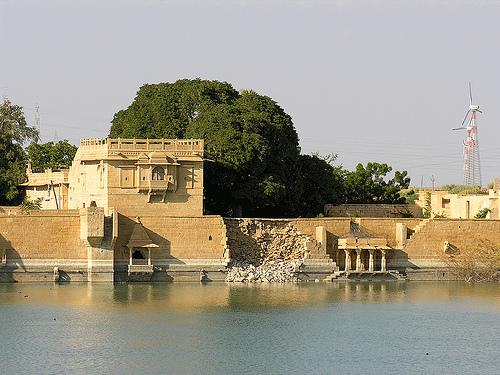 It's away from city 6 km . A pleasant garden beside a lake with mango and other fruit trees. Beautifully carved Jain temples add to its splendor.
Amar Sagar is a small and beautiful lake cum Oasis and is adjacent to a 17th Century palace called the Amar Singh Palace. Maharawal Akhai Singh built this palace in honor of one of his predecessors Amar Singh. Next to the palace are pavilions with a large stairs leading down to the Amar Sagar Lake. This haveli has been constructed in the pattern of apartments. The Amar Sagar is a five story high haveli and is famous for its murals. Wherever you go in this haveli, you will notice beautiful murals painted with delicate efforts.
You can find many of wells and ponds in the surrounding which have a royal air about them. There is an old Shiva temple in the complex itself. Amar Singh built this because he was supposed to be an ardent follower of Lord Shiva, a Hindu God related to destruction.
This 300 year old Haveli of jaisalmer's Prime Minister to Maharaja Rawal Gaj Singh Salim Singh, has a beautiful blue cupola roof with superby carved brackets in the form of peacocks. This extraordinary mansion in yellow stone is covered with intricate carvings and has an elaborate projecting balcony on the top storey. The mansion is one of the most notables of the array of havelis.
It's away from city 6 km . A pleasant garden beside a lake with mango and other fruit trees. Beautifully carved Jain temples add to its splendor.
Amar Sagar is a small and beautiful lake cum Oasis and is adjacent to a 17th Century palace called the Amar Singh Palace. Maharawal Akhai Singh built this palace in honor of one of his predecessors Amar Singh. Next to the palace are pavilions with a large stairs leading down to the Amar Sagar Lake. This haveli has been constructed in the pattern of apartments. The Amar Sagar is a five story high haveli and is famous for its murals. Wherever you go in this haveli, you will notice beautiful murals painted with delicate efforts.
You can find many of wells and ponds in the surrounding which have a royal air about them. There is an old Shiva temple in the complex itself. Amar Singh built this because he was supposed to be an ardent follower of Lord Shiva, a Hindu God related to destruction.
This 300 year old Haveli of jaisalmer's Prime Minister to Maharaja Rawal Gaj Singh Salim Singh, has a beautiful blue cupola roof with superby carved brackets in the form of peacocks. This extraordinary mansion in yellow stone is covered with intricate carvings and has an elaborate projecting balcony on the top storey. The mansion is one of the most notables of the array of havelis.
Desert National Park 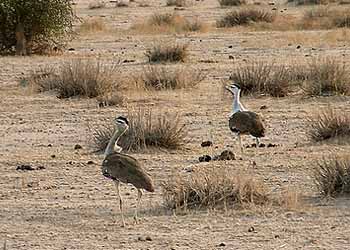 It's away from city 45 km The landscape of the Desert National Park is dominated by rolling sand dunes and scrub covered hills. The prominent fauna of the park includes black buck , chinkara, desert fox and the great Indian bustard.
The Desert National Park is situated in the Indian state of Rajasthan near jaisalmer. The Desert National Park is a protected sanctuary. The park is considered not only the largest in the state of Rajasthan but among the largest in India. The catchments area of the Desert National Park is around 3100 sq. km. The desert is a harsh place to sustain life and thus most of the fauna and flora live on the edge. Nevertheless this place attracts large hoard of migratory birds due to its close proximity to Bharatpur.
The great Indian Bustard is a magnificent bird and can be seen in considerably good numbers. It migrates locally in different seasons. The region is a heaven for migratory and resident birds of the desert. One can see many Eagles, Harriers, Falcons, Buzzards, Kestrel and Vultures. Short- toed Eagles, Tawny Eagles, Spotted Eagles, Laager Falcons and Kestrels are the most common among these.
The substantial part of the park is on a landscape, which comprises of lakebed of extinct salt lakes and thorny scrubs. It is a wonder in itself that how come living organisms flourish in these harsh conditions. Similarly, a considerable area of the Desert National Park consists of sand dunes. If you really want to explore the magnificent wildlife at the Desert National Park in jaisalmer then the best way is by setting out on an adventure-filled jeep safari. And yes, don't forget to carry a really good pair of binoculars and any of Ultra Zoom SLR cameras.
It's away from city 45 km The landscape of the Desert National Park is dominated by rolling sand dunes and scrub covered hills. The prominent fauna of the park includes black buck , chinkara, desert fox and the great Indian bustard.
The Desert National Park is situated in the Indian state of Rajasthan near jaisalmer. The Desert National Park is a protected sanctuary. The park is considered not only the largest in the state of Rajasthan but among the largest in India. The catchments area of the Desert National Park is around 3100 sq. km. The desert is a harsh place to sustain life and thus most of the fauna and flora live on the edge. Nevertheless this place attracts large hoard of migratory birds due to its close proximity to Bharatpur.
The great Indian Bustard is a magnificent bird and can be seen in considerably good numbers. It migrates locally in different seasons. The region is a heaven for migratory and resident birds of the desert. One can see many Eagles, Harriers, Falcons, Buzzards, Kestrel and Vultures. Short- toed Eagles, Tawny Eagles, Spotted Eagles, Laager Falcons and Kestrels are the most common among these.
The substantial part of the park is on a landscape, which comprises of lakebed of extinct salt lakes and thorny scrubs. It is a wonder in itself that how come living organisms flourish in these harsh conditions. Similarly, a considerable area of the Desert National Park consists of sand dunes. If you really want to explore the magnificent wildlife at the Desert National Park in jaisalmer then the best way is by setting out on an adventure-filled jeep safari. And yes, don't forget to carry a really good pair of binoculars and any of Ultra Zoom SLR cameras.Bada Bagh 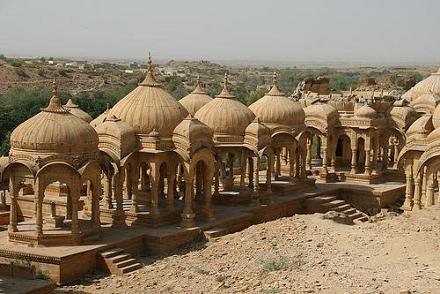 It's away from city 6 km . A fertile oasis on the bank of an artificial lake. Much of the city's fruits and vegetables are grown here. Surrounded by dense trees are the royal cenotaphs with beautifully carved ceilings and equestrian statues of the former rulers.
Bada Bagh, which literally means 'Big Garden', is located on the Ramgarh road. It was commissioned by Maharawal Jait Singh in the early 16th century and completed by his son Lunakaran after his death.
The site has three different things to watch, a garden, a tank and a dam. In the vicinity itself you will find Govardhan Stambh (pillar). This pillar was constructed to commemorate the construction of the Dam and the tank. In the local dialect the Dam and the tank are known as Jait Bandh and the Jait Sar respectively. It is believed that these are based on the name of the man who constructed them. The Jait Bandh is a dominating structure. It is about 1,200 feet in length and 350 feet in width. If you observe it closely you will notice that this has been built out of solid blocks of stone. The same material has been used for the construction of well as well as the tank.
Bada Bagh which literally means Big Garden is located on the Ramgarh road. It was commissioned by Maharawal Jait Singh in the early 16th century and completed by his son Lunakaran after his death. The site itself consists of a tank, a dam and a garden. Nearby you will find the Govardhan Stambh (pillar) on which are engraved the names of the dam and the water tank which are called the Jait Bandh and the Jaitsar respectively, dedicated to the man who constructed them. The Jait Bandh is a colossal structure, about 1,200 feet in length and 350 feet in width and built out of solid blocks of stone, as are the stepwells.
It's away from city 6 km . A fertile oasis on the bank of an artificial lake. Much of the city's fruits and vegetables are grown here. Surrounded by dense trees are the royal cenotaphs with beautifully carved ceilings and equestrian statues of the former rulers.
Bada Bagh, which literally means 'Big Garden', is located on the Ramgarh road. It was commissioned by Maharawal Jait Singh in the early 16th century and completed by his son Lunakaran after his death.
The site has three different things to watch, a garden, a tank and a dam. In the vicinity itself you will find Govardhan Stambh (pillar). This pillar was constructed to commemorate the construction of the Dam and the tank. In the local dialect the Dam and the tank are known as Jait Bandh and the Jait Sar respectively. It is believed that these are based on the name of the man who constructed them. The Jait Bandh is a dominating structure. It is about 1,200 feet in length and 350 feet in width. If you observe it closely you will notice that this has been built out of solid blocks of stone. The same material has been used for the construction of well as well as the tank.
Bada Bagh which literally means Big Garden is located on the Ramgarh road. It was commissioned by Maharawal Jait Singh in the early 16th century and completed by his son Lunakaran after his death. The site itself consists of a tank, a dam and a garden. Nearby you will find the Govardhan Stambh (pillar) on which are engraved the names of the dam and the water tank which are called the Jait Bandh and the Jaitsar respectively, dedicated to the man who constructed them. The Jait Bandh is a colossal structure, about 1,200 feet in length and 350 feet in width and built out of solid blocks of stone, as are the stepwells. Mool Sagar 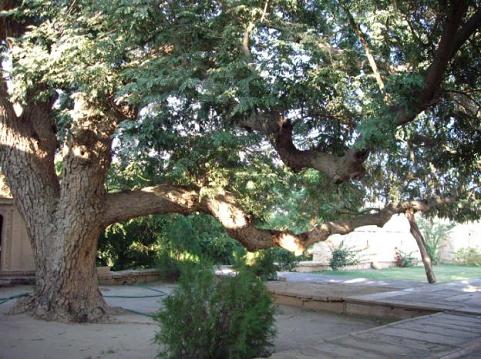 It's away from city 9 km . The pleasant shady grove is a perfect picnic spot during summers.
Situated 9 K.M. west of jaisalmer, this is another pleasant, but rather neglected, small garden and tank. It belongs to the Royal family of jaisalmer and was originally built as a cool summer retreat. The major attraction of this place is a Shiva temple, which is said to be constructed out of just two large blocks of sandstones.
Maharawal Moolraj II built the Moolsagar complex in 1815 AD. You will find numerous wells, the Moolsagar Garden and a splendid Raj Mahal built on its premises. Maharaja Moolsagar was known for his patronage to art and artisans and that becomes pretty evident when you come across some great murals on the palace walls. He definitely had a considerable influence on the wazirs and land-lords. Therefore his patronage to the art and architecture was resonated among his nobles and subjects. It was mainly due to his efforts that so many lovely palaces and structures were built in that period which was influenced by both the Mughal and Rajput schools of art.
It's away from city 9 km . The pleasant shady grove is a perfect picnic spot during summers.
Situated 9 K.M. west of jaisalmer, this is another pleasant, but rather neglected, small garden and tank. It belongs to the Royal family of jaisalmer and was originally built as a cool summer retreat. The major attraction of this place is a Shiva temple, which is said to be constructed out of just two large blocks of sandstones.
Maharawal Moolraj II built the Moolsagar complex in 1815 AD. You will find numerous wells, the Moolsagar Garden and a splendid Raj Mahal built on its premises. Maharaja Moolsagar was known for his patronage to art and artisans and that becomes pretty evident when you come across some great murals on the palace walls. He definitely had a considerable influence on the wazirs and land-lords. Therefore his patronage to the art and architecture was resonated among his nobles and subjects. It was mainly due to his efforts that so many lovely palaces and structures were built in that period which was influenced by both the Mughal and Rajput schools of art.
|

